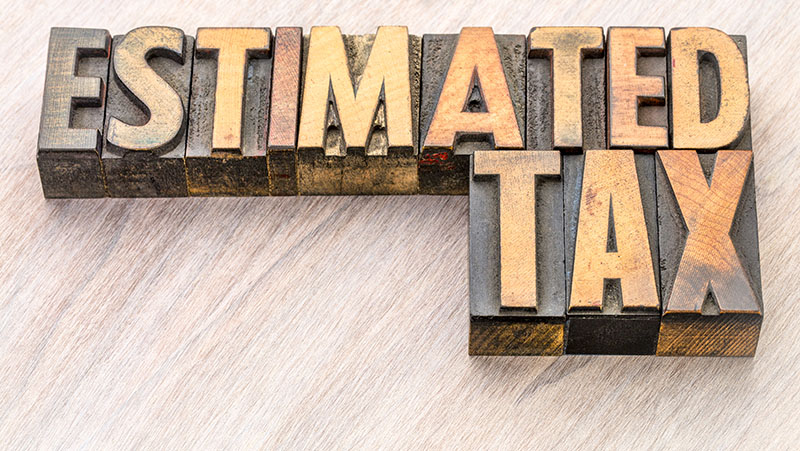What are Estimated Taxes? Do I need to Pay Them?
November, 03 2021 by Carolyn Richardson, EA, MBA
If you’ve ever had to pay a large tax bill on April 15, you may have wondered to yourself where you went wrong in having to pay so much. However, if you are a wage earner, it can sometimes seem like figuring out your correct withholding can be an endless game of Whack-a-Mole - or, in this case, Whack-a-Tax. And if you have income that isn’t subject to withholding at all – such as from self-employment or investment income like dividends and interest – you know that withholding alone isn’t likely to cover your tax liability.
And if you have income that isn’t subject to withholding at all – such as from self-employment or investment income like dividends and interest – you know that withholding alone isn’t likely to cover your tax liability.
But there is one way to solve the dilemma of owing money every April – and that is to make estimated tax payments.
What are estimated tax payments?
Estimated tax payments are additional payments that taxpayers may make on a quarterly basis to cover any additional taxes that may be due. Such payments are particularly important for individuals who do not have regular wage withholding, or who know that their withholding will be insufficient to cover their tax liability.
How do I know if I need to make estimated tax payments?
If you are using tax software to prepare your return, you can ask the software to calculate any estimated tax penalty for the current year and any estimated tax payments that may be due for the following year. For example, I will be preparing my 2021 return in the early part of 2022. If I owe money for 2021, I can ask my software to calculate the penalty (if applicable), and also ask it to produce estimated tax vouchers for 2022. These vouchers will let me know the amount of each payment and the dates by which they need to be paid. If I make those payments, I will not be subject to a penalty for 2022. Some taxpayers are not liable for the estimated tax penalty even if they owe taxes at the end of the year. You do not need to pay estimated taxes for the current year if you had no tax liability in the prior year (meaning that the tax liability on the return was $0, which is not the same as the amount you owed), and that the zero liability was for a 12-month period. To have $0 in tax liability, you generally have to have taxable income under the standard deduction amount for your filing status.
For taxpayers who expect to owe $1,000 or more when they file their return, the IRS expects them to make estimated tax payments. Corporations must make estimated tax payments if the amount owed at the end of the year is $500 or more. Of course, there are some exceptions to these rules which we'll discuss a little later. Taxpayers who work primarily as farmers and fishermen have different requirements. High income individuals also have a requirement for estimated taxes if they hit certain thresholds. If you need more information because you fall into one of these categories, please refer to Publication 505 at the IRS’s website.
Taxpayers who are self-employed must not only make estimated tax payments for their income taxes, but also to cover their self-employment taxes. If you have an unusual situation happening during the year, such as selling a property at a taxable gain, receiving a distribution from an inherited IRA, or some other large and unusual occurrence, it is probably a good idea to determine whether or not additional taxes will be owed on that money. It is possible that you may only need to make one quarter’s payment if the income is a one-time thing.
How can I avoid having to make such payments?
For those who pay their taxes through withholding, you can change your withholding at any time during the tax year. It's always a good idea to check about halfway through the year to see how much income you actually have versus how much withholding you have to make sure the amount seems reasonable.
Keep in mind the withholding tables used to calculate withholding on wages are designed primarily for single taxpayers who have earnings from only one job and no spouse. If you have a spouse who is working, or if you or they hold more than one job during the year, it's possible that the withholding on your wages is not going to be enough to cover your tax liability at the end of the year. In that case, estimated payments might be the right option to make up a potential shortfall.
It’s also a good idea to make certain that you are not only claiming the correct amount of withholding but that your employer is actually withholding the correct amount. Payroll errors do happen and it's not a good thing to find out that the amount that you thought you were having withheld was not being withheld by your employer. We have talked to a lot of taxpayers over the years whose employers failed to withhold taxes at all, something that the taxpayers did not notice until they received their W-2. Even if your employer makes an error, you have to pay the taxes.
How often do I have to make estimated tax payments?
Estimated tax payments are generally done on a quarterly basis, but these are not the quarters that we commonly think of. Estimated taxes are paid during the year that you are paying them for – so 2021’s estimated tax payments are due on April 15th, June 15th, and September 15, 2021, with the last payment due January 15, 2022. The due dates are the next business day when they fall on a weekend or holiday.
The payments are made with Form 1040-ES and most tax preparation software will prepare these vouchers for you when you file your prior year’s return (for example, the 2021 vouchers are prepared when you prepare your 2020 income tax return). The payments can either be mailed to the IRS with a check or made electronically using the EFTPS system or IRS2Go app on your phone. You can also have them set up by your tax return preparer, if you have one, to be direct debited from a checking or savings account.
What happens if I do not pay my payments on time?
Failing to make estimated tax payments when required will result in the assessment of the Underpayment of Estimated Tax Penalty. The estimated tax penalty for most taxpayers is assessed when you do not have at least 90% of your tax liability paid by the end of the tax year. For example, if my tax liability on my 2021 return is $10,000, I would have to have at least $9,000 paid to the government by January 15, 2022. The 90% rule is a general rule for most taxpayers, but taxpayers who have higher income must meet a higher threshold to avoid the penalty, and they may be required to pay up to 100% or 110% of their tax liability before the deadline. The penalty itself is an interest calculation on money that should have been paid to the US government ahead of time.
Keep in mind that most states also require that taxes be paid throughout the year and if the state withholding taxes are not enough, you should pay state estimated taxes in addition to the federal estimated tax payments. The thresholds for those vary from state to state, but you can find out more information from your state tax agency or their website.





